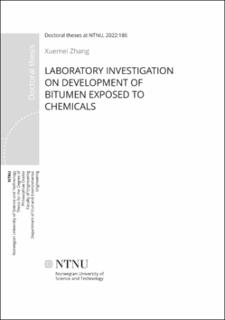| dc.contributor.advisor | Hoff, Inge | |
| dc.contributor.advisor | Garba, Saba Rabbira | |
| dc.contributor.author | Zhang, Xuemei | |
| dc.date.accessioned | 2022-06-02T06:57:42Z | |
| dc.date.available | 2022-06-02T06:57:42Z | |
| dc.date.issued | 2022 | |
| dc.identifier.isbn | 978-82-326-6723-9 | |
| dc.identifier.issn | 2703-8084 | |
| dc.identifier.uri | https://hdl.handle.net/11250/2997297 | |
| dc.description.abstract | As one of the most significant components of asphalt concrete, bitumen is crucial to the durability and lifespan of asphalt pavement. The asphalt pavement is exposed to different external conditions, such as traffic loading, temperature, ultraviolet radiation and chemicals. These external factors can significantly reduce the durability and longevity of asphalt pavement and are accompanied by high maintenance and reparation cost. Therefore, knowledge about how these factors affect bitumen performance is of significance for pavement design and precaution measures. Many of these external factors have been investigated in several research projects in the past. However, researchers have paid less attention to the influence of external chemicals on bitumen.
This research simulates the practical situation of asphalt pavement under chemical conditions in the laboratory to study the chemical effect on bitumen performance and the resultant mechanisms. To do this, three common chemical solutions were prepared in the laboratory based on Norwegian or European situation: Sodium chloride (10 wt%), calcium chloride (10 wt%) and acid rain (pH 4); Five variations of bitumen were selected: neat bitumen, short-term aged bitumen, long-term aged bitumen, polymer modified bitumen and rejuvenated bitumen; Three immersion time were applied: seven, twenty-eight and ninety days. After the immersion process, the pH value test was conducted to investigate the hydrogen ion concentration in the residual solution. Scanning electron microscopy with energy dispersive spectrometer test was applied to analyse the morphology and element content of bitumen. Penetration, softening point and viscosity tests were carried out to characterise the physical properties of bitumen. Attenuated total reflectance Fourier transform infrared radiation spectroscopy was used to analyse the chemical structure of bitumen and the reaction between bitumen and chemicals. Besides, the rheological properties of bitumen were evaluated by temperature and frequency sweep modes of dynamic shear rheometer and bending beam rheometer tests. The mechanical properties of bitumen were characterised by multiple stress creep recovery test and linear amplitude sweep test.
The experimental results show that three chemicals have similar effects on the physical, rheological and mechanical properties of neat and short-term aged bitumen as conventional thermal-oxidative ageing, resulting in a stiffer and aged bitumen. The hardening and oxidative degrees were accentuated over immersion time. However, different observations on the morphology, element content and chemical structure of bitumen were found because of the
distinct deterioration mechanisms caused by various chemicals. Furthermore, various bitumen responded differently to chemicals due to various reaction mechanisms, especially in surface characterisation, softening point, dynamic viscosity, non-recoverable creep compliance and recovery percent. It is concluded that polymer modified bitumen has the best resistance to chemicals, neat bitumen has the worst resistance to chemicals, rejuvenated bitumen and short-term aged bitumen show moderate resistance to chemicals. Besides, NaCl, CaCl2 and acid exert the most significant impacts on neat bitumen and aged bitumen, polymer modified bitumen, and rejuvenated bitumen, respectively.
The experimental results suggest that chemical immersion should be paid the same attention to thermal-oxidative ageing. Calcium chloride is a better option for de-icing strategy compared to sodium chloride during winter maintenance from the perspective of damage (but much more expensive). Moreover, polymer modified bitumen could be the best choice for pavement design in acid rain and snowy regions where a “bare road strategy” is applied for the winter maintenance. It is hoped that this study can contribute to understanding the effect of environmental chemicals on asphalt pavement and establish a standard for the solution ageing of bitumen. | en_US |
| dc.language.iso | eng | en_US |
| dc.publisher | NTNU | en_US |
| dc.relation.ispartofseries | Doctoral theses at NTNU;2022:186 | |
| dc.relation.haspart | Paper 1: Zhang, Xuemei; Chen, Hao; Hoff, Inge. The mutual effect and reaction mechanism of bitumen and de-icing salt solution. Construction and Building Materials 2021 ;Volum 302. https://doi.org/10.1016/j.conbuildmat.2021.124213 This is an open access article under the CC BY license (http://creativecommons.org/licenses/by/4.0/). | en_US |
| dc.relation.haspart | Paper 2: Zhang, Xuemei; Hoff, Inge; Saba, Rabbira Garba. Response and deterioration mechanism of bitumen under acid rain erosion. Materials 2021 ;Volum 14.(17) https://doi.org/10.3390/ma14174911 This is an open access article under the CC BY license (http://creativecommons.org/licenses/by/4.0/). | en_US |
| dc.relation.haspart | Paper 3: Zhang, Xuemei; Hoff, Inge; Chen, Hao. Characterization of various bitumen exposed to environmental chemicals. Journal of Cleaner Production 2022 ;Volum 337. https://doi.org/10.1016/j.jclepro.2022.130610 This is an open access article under the CC BY license (http://creativecommons.org/licenses/by/4.0/). | en_US |
| dc.relation.haspart | Paper 4: Zhang, Xuemei; Hoff, Inge. Comparative study of thermal-oxidative aging and salt solution aging on bitumen performance. Materials 2021 ;Volum 14.(5) s. 1-14 Thttps://doi.org/10.3390/ma14051174his is an open access article under the CC BY license (http://creativecommons.org/licenses/by/4.0/). | en_US |
| dc.title | Laboratory Investigation on Development of Bitumen Exposed to Chemicals | en_US |
| dc.type | Doctoral thesis | en_US |
| dc.subject.nsi | VDP::Technology: 500::Environmental engineering: 610 | en_US |
